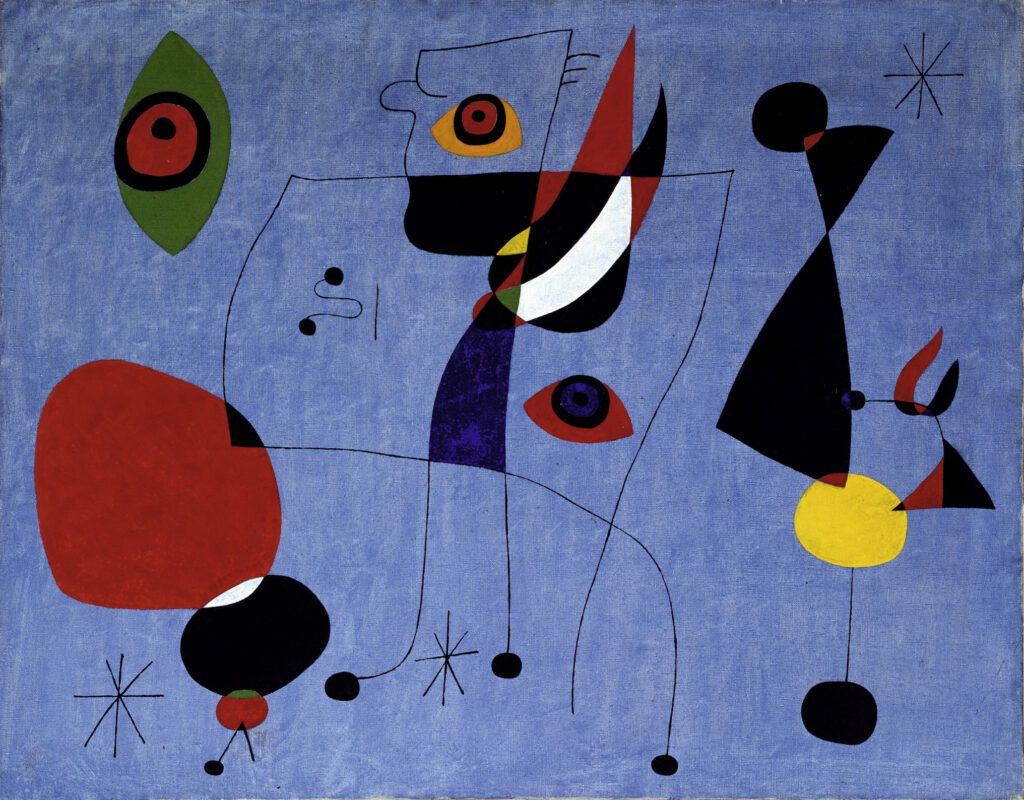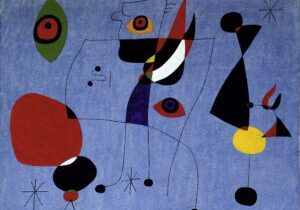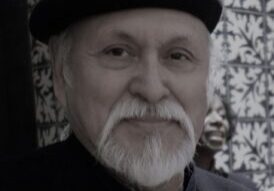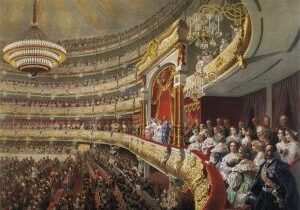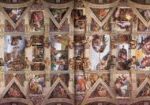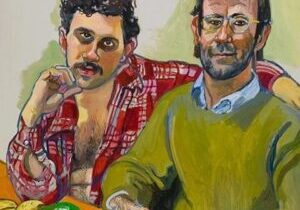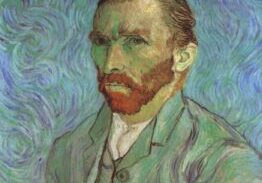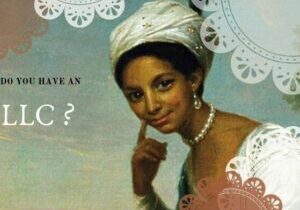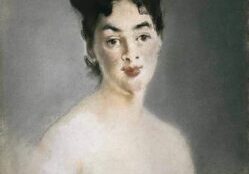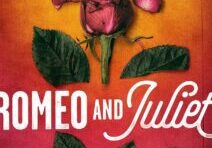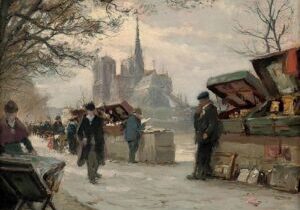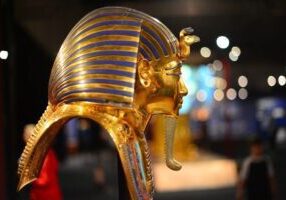When acclaimed Spanish artist Joan Miró entered his later years, something peculiar happened—he became more prolific during a time when others slowed down.
The 90 year-old native of Barcelona produced 57 works that spanned into sculptures, drawings, and paintings in his golden years. Now, his collection is making its way to the McNay Art Museum’s latest exhibit titled, “Miró: The Experience of Seeing” on display from September 30 through January 10.
Not only is San Antonio the last stop before returning to Spain, but also having it at such a seminal institution in the city’s art scene seems only fitting. While the exhibition focuses on his works which started in the 1960s, the pieces in question represent a much more personal side to the often-immortalized abstract master.
The son of a watchmaker and goldsmith routinely played with traditional spaces in his work starting during his time studying at the School of Industrial and Fine Arts in Barcelona. It was not until his stint at the La Lonja School of Fine Arts in 1918 that he would get his first solo show at the Dalmau Galleries.
From then on, Miró became synonymous with collaborations with other artists and movements—especially during his time in Paris where influences included the likes of psychologist Sigmund Freud and his academic writings. Bright colors and shapes defined his works with overt interludes with fauvism and cubism.
While it may be easy to characterize his later pieces as part of his public art contributions, “Miró: The Experience of Seeing” strives for a different profile for the artist. It is a chance to see a master that was still playing with space on both canvas and sculpture pieces.
“Miró: The Experience of Seeing” is as much a collaborative effort as it is a visual triumph.

The brains behind the exhibit included chief curator of Sculpture Carmen Fernández Aparicio and chief curator of Paintings Belén Galán Martín. Both curators were under the guidance of Rosario Peiró, the chief curator of the Permanent Collection at the Museo Nacional Centro de Arte Reina Sofía in Madrid, Spain.
Calling the famed Catalan artist inventive in his methods is an understatement. Amid his extensive cathartic pilgrimages during his life, he experimented with assembling found objects and adding techniques such as modeling and bronze casting. Such techniques became commonplace among his contemporaries.
Now as patrons revisit his later catalog, the emphasis in sculpture, paintings and drawings evoked symbolism rather than the exact human form. In short, the entire collection is a portrait of a man in transition. The gallery illustrates an evolution from early artistic movements to a far more pensive artist.

During his illustrious career, Joan Miró was one of the few artists that found appreciation in his own time. Yet that would be nothing compared to the legacy that grew after his passing. Trying to imagine modern art without the likes Miró is nearly impossible. Thanks to the latest exhibit at the McNay Art Museum, seeing his masterworks is possible.
For more information and other upcoming exhibitions at the McNay Art Museum, visit www.mcnayart.org
La Exposición de “Miró: la experiencia de ver”
por Kristian Jaime
Kristian@kristianjaime.com
Cuando el aclamado artista español Joan Miró entro en sus últimos años de su vida, algo muy extraño le sucedió. Él empezó a ganar mucha fama durante un tiempo cuando otros ya se estaban jubilando.
A los 90 años de edad el famoso artista, originario de Barcelona, produjo 57 obras. Entre ellas se incluyen esculturas, dibujos y pinturas todas cuales surgieron durante sus años dorados. Ahora su colección está recorriendo su camino hacia el Museo de Arte McNay en una última exposición titulada "Miró: la experiencia de ver" del 30 de septiembre de 2015 hasta el 10 de enero de 2016.
Parece lógico que la última escala de la gira estadounidense antes de regresar a España se tome acabo en un museo tan prestigioso como el McNay, ya que se encuentra en la cima de la escena de arte de la ciudad de San Antonio. Aunque la exposición se enfoca principalmente en sus obras que comenzó en la década de 1960, las piezas en cuestión representan un lado mucho más personal que resaltan el ingenio del artista.
Desde el principio de su carrera Miró muy a menudo recreaba los espacios tradicionales en sus obras ya que era el hijo de un joyero y relojero. No fue hasta su etapa en la escuela de La Lonja de Bellas Artes en 1918 que consiguió su primer exposición privada en las galerías Dalmau.

Femme et Oiseau dans la Nuit by: Miro
A partir de entonces, Miró se convirtió casi sinónimo con las colaboraciones de otros artistas y movimientos. Fue especialmente durante su tiempo en París, cuando sus influencias empezaron a incluir hasta algunas del psicólogo Sigmund Freud y sus escrituras académicas. Los colores brillantes y las formas definidas se convirtieron sinónimas con sus obras y eran típicas del surrealismo, el Fauvismo y el cubismo.
Aunque seria fácil caracterizar sus obras posteriores como parte de sus contribuciones de arte público, "Miró: la experiencia de ver" nos demuestra un perfil diferente del artista. La exhibición nos da una oportunidad de ver los frutos de un artista que usaba su genio en ambos la pinturas, las esculturas, y sus dibujos.
"Miró: la experiencia de ver" es tanto como un esfuerzo colaborativo como es un triunfo visual.

Los cerebros que planearon la exposición incluyen a la Comisaria Jefe de esculturas Carmen Fernández Aparicio y el Comisario Jefe de pinturas Belén Galán Martín. Ambos Comisarios estaban bajo la directa supervisión de Rosario Peiró, la Comisaria de la Colección Permanente del Museo Nacional Centro de Arte Reina Sofía de Madrid, España.
Miró, el famoso artista catalán, cambio su estilo de arte varias veces durante su vida. Durante sus extensas emigraciones, él experimentó con murales cerámicos. También, se educo a hacer montaje de objetos que encontraba, y aprendió diferentes técnicas como el modelado y fundición de bronce. Miró era un creador que no se ataba a una sola manera de formar sus obras, sino que siempre intercambiaba en la técnica que mejor le parecía en ese momento, su falta de lealtad en una sola forma de arte es lo que lo distingue de los otros artistas de su tiempo.

Hoy en día cuando los artistas, coleccionistas, mecenas, y críticos de arte estudian su arte y se enfocan en sus esculturas, dibujos y pinturas se van dando cuenta de su significado profundo e importancia altamente simbólica que su arte representa. En resumen, toda la colección es un retrato de un hombre en transición. La galería demuestra una evolución desde sus movimientos artísticos principios a aquellos de a un artista mucho más abstraído.
Durante su ilustre carrera, Joan Miró fue uno de los pocos artistas que si fue apreciado en su propio tiempo. Miró se encontraba en el lugar correcto en el momento justo. Sin embargo, eso sería nada comparado con el legado que creció después de su fallecimiento. Imaginarse el arte moderno sin la talla Miró es casi imposible. Gracias a la última exposición en el Museo de Arte McNay, mirando a Miró y sus obras maestras si será posible.
